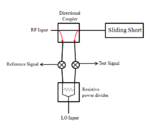Hawaslsh
Full Member level 3
- Joined
- Mar 13, 2015
- Messages
- 164
- Helped
- 5
- Reputation
- 10
- Reaction score
- 7
- Trophy points
- 1,298
- Location
- Washington DC, USA
- Activity points
- 3,422
Hello All,
I had a question regarding the phase relation between the RF input and IF output of a down converting mixer. I am attempting to make a device which can measure the phase or delay of a particular DUT at X-band. I attached a simplified block diagram of the circuit below.

I am using a directional coupler to sample the forward the and reverse traveling wave. I am using the sampled forward traveling wave as a phase reference to compare and calculate the phase change seen in the sampled reverse traveling wave. For testing purposes i am using a sliding short as the DUT because I thought it would be an easy / controlled way to vary the phase ±180°. As a note, path lengths for the LO pumps are the same so the LO phase should be equal.
As i moved the sliding short I expected to see the phase of the IF test signal vary ± 180° compared to the IF reference. Due to finite directivity I also expected the amplitude of the IF singles to vary.

Above is a plot showing the maximum phase shift observed between the IF reference and test signal. For this test the RF = 8.4 GHz, LO = 8.399 GHz creating an IF = 1 MHz. Despite moving the sliding short 180° I only observed a 22 ns delay or ~8° of phase difference in the IF test signal between the two short positions. Long story short, should i actually expect to see 180 degrees of phase shift between the down converted IF test and reference signals? Not sure if its coincidence, but the measured IF delay is equivalent to a ~λ/4 delay at 8.4 GHz since my sliding short has an air dielectric.
Sorry for the super long post, hope it makes sense,
Thanks in advance,
Sami
I had a question regarding the phase relation between the RF input and IF output of a down converting mixer. I am attempting to make a device which can measure the phase or delay of a particular DUT at X-band. I attached a simplified block diagram of the circuit below.

I am using a directional coupler to sample the forward the and reverse traveling wave. I am using the sampled forward traveling wave as a phase reference to compare and calculate the phase change seen in the sampled reverse traveling wave. For testing purposes i am using a sliding short as the DUT because I thought it would be an easy / controlled way to vary the phase ±180°. As a note, path lengths for the LO pumps are the same so the LO phase should be equal.
As i moved the sliding short I expected to see the phase of the IF test signal vary ± 180° compared to the IF reference. Due to finite directivity I also expected the amplitude of the IF singles to vary.

Above is a plot showing the maximum phase shift observed between the IF reference and test signal. For this test the RF = 8.4 GHz, LO = 8.399 GHz creating an IF = 1 MHz. Despite moving the sliding short 180° I only observed a 22 ns delay or ~8° of phase difference in the IF test signal between the two short positions. Long story short, should i actually expect to see 180 degrees of phase shift between the down converted IF test and reference signals? Not sure if its coincidence, but the measured IF delay is equivalent to a ~λ/4 delay at 8.4 GHz since my sliding short has an air dielectric.
Sorry for the super long post, hope it makes sense,
Thanks in advance,
Sami
